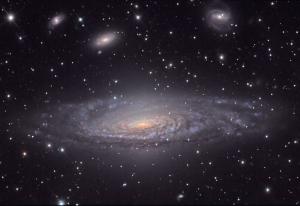NGC 7331 – Spiral Galaxy in Pegasus
What would the Andromeda Galaxy look like were it 20 times more distant? To find the answer, we need look no further than the spiral galaxy NGC 7331 in Pegasus. In size (a 130,000 LY diameter) and mass (300 billion suns), NGC 7331 is essentially a twin of the Andromeda Galaxy. Place the Andromeda Galaxy beside NGC 7331 and it, too, would be a magnitude 9.5 “faint fuzzy” with 10.5 by 3.5 arcminute dimensions.
I first viewed NGC 7331 in the fall of 1977, using a 3-inch reflector and a magnifying power of 60X. To me it appeared as “a faint small object that seemed slightly elliptical.” A recent observation with a 4.5-inch reflector yielded a similar result. In both instances, I was seeing the galaxy’s nucleus. Would a larger scope reveal the spiral arms? A 10-inch reflector did, but barely. In my logbook, I wrote, “Some hint of extensions – like a small, faint M31.”
The accompanying finder chart shows the location of NGC 7331 – a 4 ½ degree star-hop north and slightly west of eta (η) Pegasi. Just ½ degree SSW of NGC 7331 is Stephan’s Quintet. This clump of galaxies, ranging in magnitudes from 12.7 to 13.1) is a favorite target of owners of large-aperture telescopes.
- Author:
- Glenn Chaple
- Entry Date:
- Nov 14, 2013
- Published Under:
- Glenn Chaple's Columns



